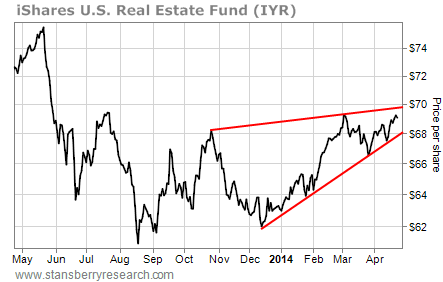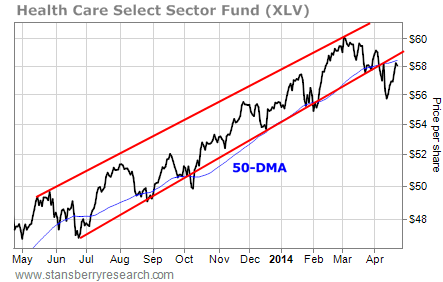The stock market fired a warning shot earlier this month.
After setting a new all-time high above 1,894, the S&P 500 dropped 80 points – roughly 4.2% – in just two weeks. This fast downside action is just a small sample of what may happen when the stock market finally enters a correction phase.
But we’re not there yet. As I said last week, the old bull market still has one more kick left in it.
[ad#Google Adsense 336×280-IA]And the recent bounce is giving traders a chance to cash out on some long positions and make a short trade or two.
You see, the bounce is ending.
As I told you on Tuesday, we’re coming up on a seasonally weak period for stock prices.
And there are two sectors in particular that look vulnerable for a decline…
Let’s start with real estate.
Here’s a chart of the iShares U.S. Real Estate Fund (IYR)…
 For the past six months, IYR has been trading in a bearish rising-wedge formation. In this pattern, a stock makes consistently higher highs and higher lows but the distance between each new high and low is smaller. Eventually, the stock has to break out of the pattern one way or another. When that happens, it usually results in a big move.
For the past six months, IYR has been trading in a bearish rising-wedge formation. In this pattern, a stock makes consistently higher highs and higher lows but the distance between each new high and low is smaller. Eventually, the stock has to break out of the pattern one way or another. When that happens, it usually results in a big move.
Most of the time, a rising wedge breaks to the downside. We saw this happen recently with the financial sector. The Financial Select Sector Fund (XLF) broke its rising-wedge pattern to the downside and lost more than 5% in just a few days. The chart of IYR shows similar potential.
Right now, IYR is bumping into the resistance line of the rising-wedge pattern. Aggressive traders can put on a short trade here in anticipation of the resistance line holding and turning IYR back down. A minor move down that takes back half the height of the wedge gives us a downside target of about $64 per share. A strong move lower will reverse the entire wedge pattern and target $61 per share.
The other sector that looks like a low-risk short sale is health care. Here’s the chart of the Health Care Select Sector Fund (XLV)…
 XLV broke down from a rising-channel pattern earlier this month. It also broke below its 50-day moving average (DMA). Over the past two weeks, though, XLV has bounced back up and is now testing the former support line of the rising channel. It’s also testing its 50-DMA.
XLV broke down from a rising-channel pattern earlier this month. It also broke below its 50-day moving average (DMA). Over the past two weeks, though, XLV has bounced back up and is now testing the former support line of the rising channel. It’s also testing its 50-DMA.
XLV is unlikely to overcome this “double resistance” on its first attempt. So aggressive traders can look to short the health care sector here in anticipation of the resistance lines holding and turning XLV lower again. The immediate downside target for XLV is the February low at about $55 per share.
The real estate and health care sectors have both benefited from the recent bounce in the stock market. But as we come to an end of the seasonally strong second half of April and roll into the seasonally weak period that starts in May, traders should take advantage of the chance to profit on the potential downside of these two sectors.
Best regards and good trading,
Jeff Clark
[ad#stansberry-ps]
Source: The Growth Stock Wire


